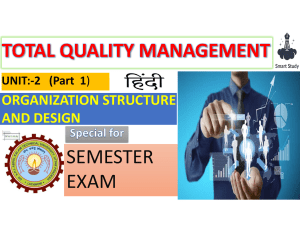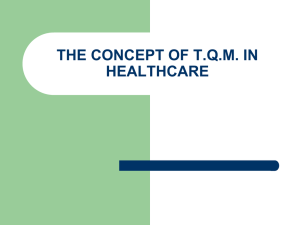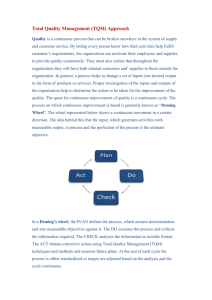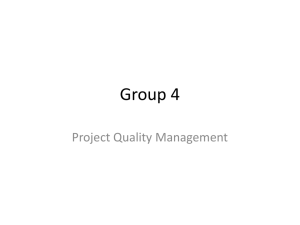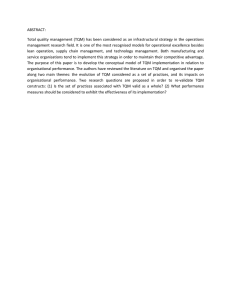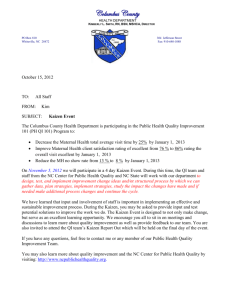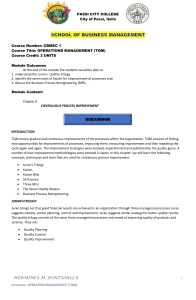Document 15504153
advertisement
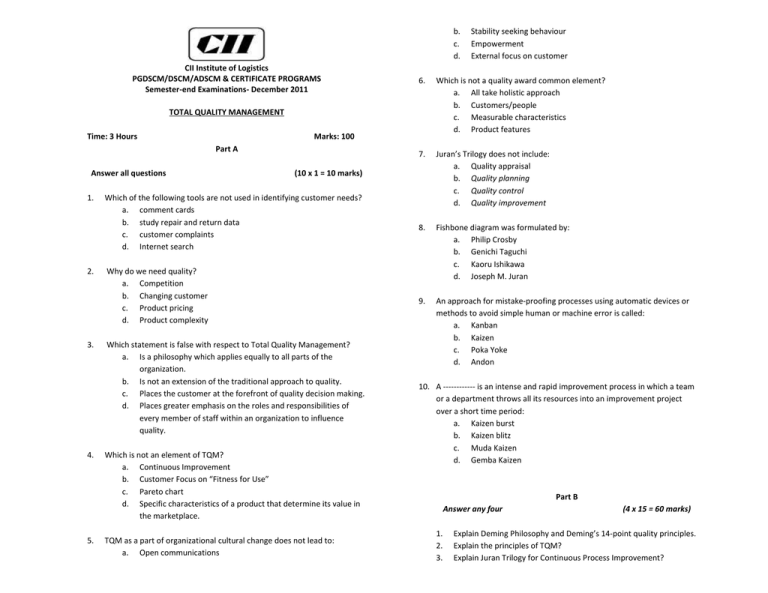
b. c. d. CII Institute of Logistics PGDSCM/DSCM/ADSCM & CERTIFICATE PROGRAMS Semester-end Examinations- December 2011 6. Which is not a quality award common element? a. All take holistic approach b. Customers/people c. Measurable characteristics d. Product features 7. Juran’s Trilogy does not include: a. Quality appraisal b. Quality planning c. Quality control d. Quality improvement 8. Fishbone diagram was formulated by: a. Philip Crosby b. Genichi Taguchi c. Kaoru Ishikawa d. Joseph M. Juran 9. An approach for mistake-proofing processes using automatic devices or methods to avoid simple human or machine error is called: a. Kanban b. Kaizen c. Poka Yoke d. Andon TOTAL QUALITY MANAGEMENT Time: 3 Hours Marks: 100 Part A Answer all questions 1. 2. 3. 4. 5. (10 x 1 = 10 marks) Which of the following tools are not used in identifying customer needs? a. comment cards b. study repair and return data c. customer complaints d. Internet search Why do we need quality? a. Competition b. Changing customer c. Product pricing d. Product complexity Which statement is false with respect to Total Quality Management? a. Is a philosophy which applies equally to all parts of the organization. b. Is not an extension of the traditional approach to quality. c. Places the customer at the forefront of quality decision making. d. Places greater emphasis on the roles and responsibilities of every member of staff within an organization to influence quality. Which is not an element of TQM? a. Continuous Improvement b. Customer Focus on “Fitness for Use” c. Pareto chart d. Specific characteristics of a product that determine its value in the marketplace. TQM as a part of organizational cultural change does not lead to: a. Open communications Stability seeking behaviour Empowerment External focus on customer 10. A ------------ is an intense and rapid improvement process in which a team or a department throws all its resources into an improvement project over a short time period: a. Kaizen burst b. Kaizen blitz c. Muda Kaizen d. Gemba Kaizen Part B Answer any four 1. 2. 3. (4 x 15 = 60 marks) Explain Deming Philosophy and Deming’s 14-point quality principles. Explain the principles of TQM? Explain Juran Trilogy for Continuous Process Improvement? 4. 5. 6. What do you mean by ‘Zero Defects’? What are the 14 steps that Crosby has suggested to build up Zero Defects movement? Explain the concepts of Six Sigma? Discuss about ISO 9000:2000 Quality Systems? Part C Case Study (3*10=30 marks) Read the case and answer the questions given below: CARCOM: THE TQM INITIATIVE ‘Carcom’ is a supplier of automotive safety components employing around 700 staff which is located on two sites in Northern Ireland. The company was originally American owned but after a joint venture with a Japanese partner in the late 1980s, it was eventually bought out by the latter. The quality initiative began in 1988-89 with a five-year plan based on the Kaizen philosophy, this concept having been picked up from the Japanese partner. This was driven by senior management in response to what they saw as increasing customer demand and operating considerations. The achievement of ISO 9001 registration in 1990 brought together processes carried out by departments which had previously been undertaken in isolation. The company is now focusing on Kaizen with the principles of improvement, customer delight, systems focus and participation. A range of quality management tools and techniques are used. A TQM steering committee is responsible for overall direction but there is also a further steering committee to oversee implementation of the Quality Improvement Teams (QITs) as well as a full time coordinator. There are teams of shop floor operators based on natural workgroups, and these tend to focus on product problems and environmental issues (such as working conditions). In contrast, Kaizen teams focus on process improvements (for example, die change) and problem-solving workgroups are established in response to specific customer concerns (for example, warranty claims). Senior managers stress that a long-term approach is now being taken which is in contrast to some of the programmes in the early 1980s. These former piecemeal initiatives included quality circles which had been characterized by considerable changes in personnel , with a number of champions having moved on leaving behind a flagging initiative in contrast, the company is now taking time to get the processes right and providing a central focus through quality for change. Cultural change is the aim but it is recognized that only incremental progress can be achieved and that a supportive attitude is required from management Thus, QIT members are given extensive training and are encouraged to tackle problems which give early success and build teamwork, rather than put pressure on teams to deliver immediately on big issues. The Impact of the TQM Initiative While it is still early days, the initiative is already felt to have had a major impact. The management structure has been reduced by one layer, shop floor layout has been improved, and scrap rates, stock, work-in-progress and inspection times have been reduced, so too have the numbers of inspectors, whose role is now seen as one of analysts. Employee response to these changes has generally been positive, and the company has spent considerable effort in relating ‘quality’ directly to employees’ work, particularly through the use of measures which are displayed adjacent to the workstation and maintained by staff themselves. The unions were assured that there would not be job losses as a result of Kaizen, although they continue to have concerns about this and also raise the issue of payment for changes in job roles – particularly in relation to SPC. The company has adopted an open information policy to foster greater trust at the workplace, and businessrelated issues are given greater prominence at the joint works committee meetings. Management also believe that the quality initiative has led to a reduction in union influences although this was not an original objective. The Strategic Nature of the Human Resource Function The human resource function has emerged from a welfare to a more strategic role in recent years. This has been assisted by an MD who is regarded as a ‘people’ s person’ claiming that ‘you can’t divorce people from quality,’ and by the appointment of a personnel director to the board together with a new industrial relations manager. This has broadened the role of human resources and enhanced its status The appointment of a training manager was significant, since under the previous regime little off-the-job training was conducted. Training budgets have actually increased in volume and monetary terms despite the company’s recently recorded trading losses. Recruitment and selection are becoming more sophisticated as the company wish to identify team workers. The links between human resources and quality were made explicitly by tbe MD : “We cannot separate HR from TQM, and without HR the QIP will not work effectively.” In addition to the issues mentioned above, the function was also seen as being important in building the people aspect into the strategic quality planning process. Addressing the problem of absenteeism, and supporting line management by helping to change employee attitudes/organizational culture. In addition, the function has provided appropriate training programmes for quality, in which there has been considerable investment in time and resources, it has counseled the mentors to the QIT, and ensured that managers communicate with staff by providing advice on the best means of doing this. Quality principles are also being developed in relation to the human resource function, with specific targets being set (for example, for absenteeism) as well as more general aims (for example, on training). Questions: 1. What does the case study demonstrate about the contribution a personnel/HRM function can make to the development of TQM in an organization? 2. How might the principles of TQM be applied to a personnel function? 3. What general implications does TQM have for industrial relations? ************************************
